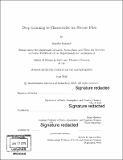Deep learning to characterize ice stream flow
Author(s)
Kanniah, Brindha.
Download1119388886-MIT.pdf (8.724Mb)
Other Contributors
Massachusetts Institute of Technology. Department of Earth, Atmospheric, and Planetary Sciences.
Advisor
Brent Minchew.
Terms of use
Metadata
Show full item recordAbstract
The physical properties of glacial beds have tremendous influence over ice flow motion, especially in regions where the ice sheet is shallow and tidally-modulated. In these regions, basal shear stress dominates the force balance of ice sheets, while basal slip along the ice-bed interface is the primary component of ice flow. However, the physical parameters of glacial beds are poorly understood due to limited observational information available, as these beds lie under ice sheets with depths up to a few 1000s of meters. Thus, our research goal is to better understand the mechanics of glacier beds, which will improve out understanding of how ice sheets respond to changing climates and shape the solid Earth. Specifically, we test if deep learning is a method that is capable of capturing the temporal evolution of ice flow. Our results show that recurrent neural networks built from Long Short-Term Memory units are a promising method for learning oscillatory patterns in ice stream dynamics. In addition, these networks can function as forecast models which create a sequence of predictions conditioned on past observations. This confirmation paves the way for further research into creating a continuous spatial-temporal model of ice flow, by applying deep learning methods on sparse observational data of glaciers.
Description
Thesis: S.M. in Earth and Planetary Sciences, Massachusetts Institute of Technology, Department of Earth, Atmospheric, and Planetary Sciences, 2019 Cataloged from PDF version of thesis. Includes bibliographical references (pages 72-75).
Date issued
2019Department
Massachusetts Institute of Technology. Department of Earth, Atmospheric, and Planetary SciencesPublisher
Massachusetts Institute of Technology
Keywords
Earth, Atmospheric, and Planetary Sciences.